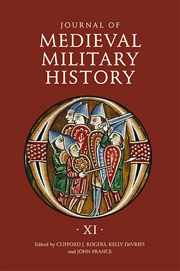Book contents
- Frontmatter
- Contents
- List of Illustrations and Tables
- 1 Military Games and the Training of the Infantry
- 2 The Battle of Civitate: A Plausible Account
- 3 The Square “Fighting March” of the Crusaders at the battle of Ascalon (1099)
- 4 How the Crusades Could Have Been Won: King Baldwin II of Jerusalem's Campaigns against Aleppo (1124–5) and Damascus (1129)
- 5 Saint Catherine's Day Miracle – the Battle of Montgisard
- 6 The Military Effectiveness of Alan Mercenaries in Byzantium, 1301–1306
- 7 Winning and Recalling Honor in Spain: Pro-English Poetry in Celebration of the Battle of Nájera (1367)
- 8 The Wars and the Army of the Duke of Cephalonia Carlo I Tocco (c. 1375–1429)
- 9 Sir John Radcliffe, K.G. (d. 1441): Miles Famossissimus
- 10 Defense Schemes of Southampton in the Late Medieval Period, 1300–1500
- 11 French and English Acceptance of Medieval Gunpowder Weaponry
- Journal of Medieval Military History 1477–545X
4 - How the Crusades Could Have Been Won: King Baldwin II of Jerusalem's Campaigns against Aleppo (1124–5) and Damascus (1129)
Published online by Cambridge University Press: 05 October 2013
- Frontmatter
- Contents
- List of Illustrations and Tables
- 1 Military Games and the Training of the Infantry
- 2 The Battle of Civitate: A Plausible Account
- 3 The Square “Fighting March” of the Crusaders at the battle of Ascalon (1099)
- 4 How the Crusades Could Have Been Won: King Baldwin II of Jerusalem's Campaigns against Aleppo (1124–5) and Damascus (1129)
- 5 Saint Catherine's Day Miracle – the Battle of Montgisard
- 6 The Military Effectiveness of Alan Mercenaries in Byzantium, 1301–1306
- 7 Winning and Recalling Honor in Spain: Pro-English Poetry in Celebration of the Battle of Nájera (1367)
- 8 The Wars and the Army of the Duke of Cephalonia Carlo I Tocco (c. 1375–1429)
- 9 Sir John Radcliffe, K.G. (d. 1441): Miles Famossissimus
- 10 Defense Schemes of Southampton in the Late Medieval Period, 1300–1500
- 11 French and English Acceptance of Medieval Gunpowder Weaponry
- Journal of Medieval Military History 1477–545X
Summary
In the wake of the First Crusaders' conquest of Jerusalem on 15 July 1099, four Latin Christian (or “Frankish”) settlements were established in the Near East – the so-called “crusader states” of the kingdom of Jerusalem, the principality of Antioch and the counties of Edessa and Tripoli. For the next two centuries, western European settlers and crusaders sought to defend these isolated polities – “the lands beyond the sea”, or “Outremer”, as they were known collectively in the Middle Ages – struggling to preserve Latin Christendom's fragile foot-hold in the Holy Land. Ultimately they failed. Frankish fortunes waned after the first flush of success and, as the Muslim powers of the Near East began to claw back territory, the power of the crusader states diminished. Outremer's dismemberment was gradual, but seemingly inexorable. The loss of Edessa to the Turkish warlord Zangi in 1144 led to the eradication of the first crusader state. The Ayyubid Sultan Saladin captured Jerusalem in 1187 and, barring a brief period of recovery, the Holy City remained in the hands of Islam until the twentieth century. With the advent of the more bellicose Mamluk sultanate in the mid-thirteenth century, the pace of Muslim reconquest accelerated: Antioch fell in 1268; Tripoli in 1289; and finally Acre in 1291. With that, the last vestiges of Latin rule on the Levantine mainland disappeared.
- Type
- Chapter
- Information
- Journal of Medieval Military HistoryVolume XI, pp. 73 - 94Publisher: Boydell & BrewerPrint publication year: 2013



